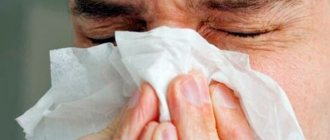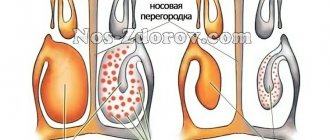Many people ask the question, what is sinusitis? This pathology is characterized by inflammation of the paranasal sinuses, which arose as a result of improper treatment of colds. If the acute form of the disease is not treated promptly, chronic sinusitis may occur.
The lesion can be localized in any sinus (ethmoidal, frontal, maxillary). It is worth noting that in normal condition, the sinuses (the cavity in the facial bones containing air) have a mucous membrane, the main property of which is to protect the body from pathogenic microorganisms.
Causes
There is a wide range of reasons why chronic sinusitis occurs. Develops as a result of incorrect treatment of inflammatory processes in the nose. The chronic stage occurs in the third or fourth week. The initial stage of development of the acute form is the entry of pathogenic agents into the paranasal sinuses. In the case when the body is initially weakened by parallel pathologies, a lack of vitamins, the attack of bacteria is activated. It is worth noting that chronic sinusitis occurs more often in adults than in children. In the younger category of the population, the disease is easier to treat.
In addition to the main factors that provoke chronic sinusitis, there are minor ones:
- allergic reaction;
- fungal infections;
- mechanical damage to the nasal septum, which blocks the outflow of fluid from the maxillary sinuses;
- asthma;
- work related to a place where the air is polluted;
- influence of tobacco smoke.
In rare cases, chronic sinusitis occurs due to problems with the teeth of the upper jaw or the presence of polypous formations in the nose.
Causes of sinusitis
The causes of sinusitis are almost always inextricably linked with stagnation of secretions in the paranasal sinuses, disruption of their aeration and subsequent infection. There are 8 sinuses in total. The nasal cavity communicates with each of them due to the presence of narrow passages. If this regular drainage is disrupted, favorable conditions are created for the development of sinusitis.
Deterioration in sinus clearance may occur for the following reasons:
- Violation of intranasal structures as a result of their deformation. This often occurs due to hypertrophic rhinitis, which is a chronic disease of the nasal sinuses associated with the proliferation of bone tissue and mucous membranes. Also, normal drainage can be disrupted by a deviated nasal septum, which occurs as a result of mechanical damage to the plate dividing the nasal cavity into two parts. The third reason for deformation of intranasal structures is congenital anomalies in the structure of the nasal concha and ethmoidal labyrinth.
- The penetration of a viral infection into the body often causes the development of sinusitis. The mucous membrane lining the sinuses reacts to the introduction of a pathogenic agent with inflammation and swelling. The glands located in the nasal mucosa begin to work harder and secrete an increased amount of secretion. As a result, the passages between the sinuses and the nasal cavity narrow even more and become clogged with thick contents. Ventilation of the sinuses is completely impaired, resulting in sinusitis.
- Bacterial flora can also cause inflammation of the paranasal sinuses. Most often, bacterial infection occurs against the background of a viral infection. Stagnation of mucus, lack of oxygen, lack of adequate ventilation - all this leads to the creation of favorable conditions for the proliferation of bacteria. The more often a person uses antibacterial drugs to treat viral rhinitis, the higher the risk that the bacterial flora will become resistant to them. This, in turn, will complicate the treatment process, making it long and labor-intensive.
- The fungal nature of sinusitis has become increasingly common in recent years. This is also explained by the irrational use of antibiotics. They negatively affect the state of human immune defense, disrupt the natural microflora of the nasal sinuses, and create favorable conditions for the proliferation of mycotic microorganisms in them.
- Sinusitis does not always have a microbial etiology. Inflammation may also develop due to exposure to cold, for example, when inhaling cold air.
- Exposure to the mucous membrane of chemicals becomes a predisposing factor for the development of sinusitis in the future.
- Vasomotor rhinitis, which is provoked by allergic reactions of the body, causes sinusitis in 80% of cases. Therefore, allergies are the most common cause of inflammation of the paranasal sinuses. The mechanism of development of the disease is explained by constant, multiple swelling of the mucous membrane of the respiratory tract, which leads to chronicity of the process.
- Another reason that can provoke the development of sinusitis is pathology of the roots of the teeth (oroantral fistula, chronic periodontitis). After tooth extraction, or due to infection of the maxillary sinus, sinusitis may develop. Filling a dental canal can also lead to the development of sinusitis, especially often when the filling material gets into the maxillary sinus. In this case, predominantly mycotic sinusitis develops.
- It is possible to develop sinusitis against the background of immunodeficiency.
Sinus microflora disturbance
American scientists note that one of the reasons why sinusitis develops is a disruption of the normal microflora in the nasal sinuses. The number of those bacteria that inhibit the growth of opportunistic flora begins to fall, resulting in inflammation.
According to various sources, about 15% of the world's population suffers from sinusitis. The main causes of bacterial inflammation are staphylococci and streptococci. However, it is known that these microorganisms can be present in the human nasopharynx, but do not provoke the development of the disease in him. Therefore, just the fact of their presence in the nasal cavity does not mean the development of sinusitis.
Scientists at the University of California at San Francisco conducted a laboratory study of the microflora of the sinuses in people with chronic sinusitis and in healthy people. The results of the study are such that in patients with sinusitis, Corynebacterium predominates in the nasal mucosa, which is commonly found on the skin, in the respiratory tract, and in the gastrointestinal tract. In healthy people, the microflora of the mucous membrane of the nasal sinuses is represented mainly by Lactobacilli.
As for Corynebacterium tuberculostearicum, it is not absolutely pathogenic for the human body, however, in large quantities it can lead to the development of inflammatory processes. Thus, when these bacteria were introduced into the nasal sinuses of mice, the animals developed sinusitis. When the sinuses were colonized with Lactobacilli, inflammation did not occur, just as with the simultaneous administration of Lactobacilli and Corynebacteria.
The scientists who conducted the experiment came to the conclusion that Lactobacilli are able to control the growth of other opportunistic microorganisms. However, experts are not yet able to explain the mechanisms of this process. However, it is possible that in the near future, in order to rid a person of sinusitis, it will be possible to inject not an antibiotic into the nose, but beneficial bacteria.
The balance of bacterial microflora is important for the nose, mouth, intestines, and vagina. If it is violated, a disease develops. Although the research is not yet complete, the results are very encouraging. It is believed that many bacterial infections will soon be treatable without the use of antibiotics.
Symptoms
Chronic sinusitis has a number of symptoms, based on which a doctor can make a diagnosis and prescribe treatment. The symptoms are similar to those that occur in the acute form of the pathology.
The main symptom is nasal congestion and discomfort in the paranasal sinuses. In addition to these signs, the patient may experience:
- discomfort in the frontal and occipital parts;
- unpleasant odor from the nose;
- general weakness, drowsiness;
- body temperature – up to 37.5 degrees, which does not drop for a long time;
- purulent discharge from the nasal passages.
Please note that symptoms are aggravated by exposure to cold or concurrent infectious pathologies. Headache is one of the main characteristic features of sinusitis, which cannot be eliminated even after the symptoms of a cold are eliminated. Also, symptoms of chronic sinusitis in adults manifest themselves in the form of sudden weight loss, the appearance of bruises under the eyes, and changes in the shade of the skin (becoming paler).
It is worth noting that if chronic sinusitis occurs as a result of an allergic reaction, the symptoms are slightly different: the headache is less frequent and not severe, and nasal congestion appears upon contact with the source of the allergy. Dust, plants, odors, and materials can act as allergens.
Symptoms of sinusitis
The fact that inflammation from the nasal cavity has spread to the mucous membrane of the sinuses may be indicated by a prolonged runny nose, when after 7-10 days of treatment a deterioration in the condition is obvious. You have to cough up often, mucopurulent discharge flows into the oropharynx and clogs the nose, making nasal breathing difficult. There may be a disturbance in the sense of smell.
Painful sensations
One of the most unpleasant symptoms of sinusitis is pain, which differs in location depending on which sinus is inflamed. With sinusitis, pain is concentrated in the front of the face (paranasal and infraorbital areas). The pain can spread to the forehead, cheekbones, and temples. With frontal sinusitis, severe and at times acute pain occurs in the forehead (above the eyebrows). With ethmoiditis (inflammation of the ethmoid labyrinth), pain is felt in the bridge of the nose, and can also radiate (“give”) to the corner of the eye. In the case of sphenoiditis, patients complain of pain that surrounds the head with a “hoop” or compresses it “in a vice.” The pain intensifies in the sun or in a hot room and can radiate to the eyeball.
Symptoms of chronic sinusitis
As sinusitis becomes chronic, the symptoms of the disease become less acute, but inflammation in the sinuses persists. Chronic sinusitis creates a constant source of infection, which, along with mucus, gets into the throat and contributes to the development of symptoms of pharyngitis. The person feels weakened and may have a fever.
Kinds
There are many categories into which the disease is classified. Let's look at the most common ones.
On the nature of inflammation
In this category, two forms are distinguished: exudative (large volume of nasal discharge) and productive (transformation of mucous tissue). In the catarrhal form, the discharge has a viscous liquid consistency; if treatment is started, then a second form occurs - a purulent form.
A characteristic feature of chronic purulent sinusitis is purulent exudate.
From the cause of occurrence
Let's look at this classification in the following table.
| Name | Etiology | Characteristic |
| Allergic | Against the background of an allergic lingering runny nose | Caused by the immune system's reaction to the source of the allergy |
| Polyposis | Due to chronic deformation of the nasal cavity | The long-term development of rhinitis provokes thickening of the nasal mucosa, which is why new growths appear on it, which quickly multiply and fill the nasal passage. The outflow of fluid is blocked, the breathing process is disrupted. Against the background of this process, chronic polypous sinusitis occurs. |
| Fungal | They are provoked by fungi of the mucor, candida, aspergillus and absidia groups. | Rarely seen. It can develop against the background of a stable or weak immune system. In the second case, the disease is dangerous, as it causes many serious complications. |
| Odotogenic | Congenital deformation (teeth located close to the sinuses). | This pathology increases the likelihood of pathogenic microorganisms entering when removing a tooth or filling material. Chronic odotogenic sinusitis can also occur against the background of diseases such as pulpitis and periodontitis. |
| Cystic | Against the background of deformation of the structure of the sinus mucosa. | A space appears that is filled with intercellular fluid, causing a cyst to form. |
| Traumatic | Due to mechanical damage to the sinus. | Occurs due to a fracture of the zygomatic or upper jaw. |
Treatment is selected depending on the type of disease, therefore, before carrying out therapy, the doctor directs the patient to undergo tests and undergo the necessary examinations.
According to the location of the inflammatory process
Inflammation can spread to one or several paranasal sinuses. If bacteria also affect the nasal mucosa, then this phenomenon is called rhinosinusitis. Let's consider the classification of pathology according to the location of the lesion:
- If pathogenic microorganisms affect the left or right sinus, this is right-sided or left-sided sinusitis.
- When several sinuses become inflamed at once, this phenomenon is called polysinusitis, which can be acute or chronic. As a rule, this form of the disease develops against the background of the formation of polyps in the nose.
- If a patient has damage to all paranasal sinuses, this pathology is called pansinusitis, and infection of several on one side is hemisinusitis.
Also, the following forms of the disease are distinguished:
- Infection of the frontal sinuses - chronic frontal sinusitis or frontal sinusitis.
- The defeat of the maxillary sinus is sinusitis.
- Inflammation of the ethmoid labyrinth – ethmoiditis.
- Infection of the sphenoid sinus – sphenoiditis.
The second form of sinusitis is the most common; as a rule, it is caused by untreated colds.
Varieties
In modern ENT practice, there are several types of chronic sinusitis. First of all, they are divided into three groups depending on the sinuses that are affected by inflammation.
According to this criterion, pathology can be:
- sphenoidal;
- frontal;
- ethmoidal.
With sphenoidal sinusitis, inflammation occurs in the sphenoid sinuses of the nose, and this disease is characterized by symptoms such as constant nasal congestion, headaches radiating to the back of the head, and lack of discharge from the nasal passages.
Frontal chronic sinusitis is the most common pathology, the symptoms of which are pronounced - heavy discharge with an unpleasant odor and high temperature.
Types of sinusitis
Ethmoidal is characterized by soreness in the area of the bridge of the nose, transparent, and subsequently thick, purulent discharge, and breathing problems. Also in medical practice, one of the most unpleasant forms of pathology is identified - maxillary chronic sinusitis. The disease occurs as a result of an inflammatory process in the maxillary sinuses, located on the upper jaw. It should be noted that maxillary sinusitis can cause the development of cancer, so it must be treated in a timely manner.
There are several types of diseases such as chronic sinusitis, depending on the causes of its occurrence, these are:
- polyposis, which occurs due to the appearance of tumor-like growths (polyps) in the nasal cavity;
- odontogenic, which occurs when a child or adult has carious teeth.
Diagnostics
Initially, the doctor conducts a general examination and reviews the medical history. Diagnostics includes several methods:
- Insertion of a special device – an endoscope – into the nasal cavity. With this procedure, the sinuses are visible, allowing the doctor to examine them. This method is called endoscopy or rhinoscopy.
- Carrying out MRI and CT to identify inflammation and blockage.
- Bacterial culture to determine the etiology of the disease. Using this method, the doctor determines which antibiotic should be prescribed to the patient.
- Analysis for an allergic reaction of the body to exclude the development of an allergic form of sinusitis.
It is difficult to determine the exact type of disease at home, so at the first signs of pathology, consult an otolaryngologist.
What is sinusitis
Often during the disease the maxillary sinus is affected, but there are cases when the process moves to the ethmoid, frontal or sphenoid zones. Sinusitis is an inflammation that occurs in the paranasal areas. The cause may be viral, fungal or allergic factors. All or several locations can be affected at once. Also, the cause of inflammation can be a traumatic factor.
Acute sinusitis
When there is a bacterial infection of the upper sinus, the inflammation is called acute. At this time, swelling of the mucous tissue occurs, which interferes with normal breathing and the flow of fluid from the nose. Acute maxillary sinusitis is provoked by a coccal infection. In this case, the person needs antibacterial treatment. If you start a runny nose, the infection can spread to other sinuses and become bilateral, resulting in frontal sinusitis, ethmoiditis or rhinitis.
The problem is diagnosed using computed tomography if one or more main signs are present, although latent forms also occur. If you don't know what acute sinusitis is, pay attention to the following symptoms:
- heat;
- fatigue;
- cough;
- fast fatiguability;
- nasal congestion;
- toothache;
- loss of smell;
- discharge of green mucus from the nose;
- bad breath.
Chronic sinusitis
If the symptoms of inflammation persist for more than 1.5 months, then this form of runny nose is called chronic sinusitis. In addition, if the symptoms and manifestations of the disease are repeated several times during the year, then ethmoiditis or damage to the sphenoid sinus can be expected. The most common symptoms of the disease include nasal congestion and a large amount of mucus that does not come out easily. It is worth paying attention to the following signs:
- heat;
- yellow or colorless nasal discharge;
- fatigue;
- toothache;
- swelling of the face, a rush of blood to it.
- Sberbank instant card
- Birth control pills that don't make you fat - a list of the best non-hormonal drugs for women
- Highlighter - what is it, how to use and apply it correctly to the skin
Catarrhal sinusitis
Occurs as a result of ARVI or influenza, which are complicated by viral bacteria. The disease is characterized by a feeling of dryness and burning in the nose, difficulty breathing, and loss of smell. In addition, general intoxication of the body occurs, inflammation of the mucous tissues of the nasal passage. For those who have not heard about catarrhal sinusitis - what it is - you should be careful. The patient must be prepared for the fact that the temperature will periodically jump to high levels. Vasoconstrictor nasal drops and painkillers will help improve the condition.
Purulent sinusitis
The disease occurs as a result of untreated acute respiratory viral infection, a deviated nasal septum, polyps, and infections of the teeth that are close to the sinuses. With such symptoms, it is necessary to urgently contact an otolaryngologist to establish a diagnosis and prescribe therapy. Purulent sinusitis is an advanced type of runny nose, which is combined with bacterial inflammation. It can take several forms: it all depends on the location of development. Often accompanied by headache and purulent nasal discharge. The patient feels general malaise and weakness.
How to properly treat chronic sinusitis
Therapy should be aimed at reducing the affected areas, eliminating the cause of sinusitis, and reducing the likelihood of frequent relapses of the disease. Treatment for chronic sinusitis includes:
- Rinsing the nose with a saline solution or a special preparation based on sea moths, for example, Aqua Maris, No-Sol or Humer.
- For the allergic form - products based on corticosteroid hormones, for example, Rhinocort Aqua, Flonase, Beconase.
- In severe stages, injectable or oral cortisteroids (Metypred).
- Drugs that reduce swelling of the mucous membrane and eliminate breathing problems (Actifed).
- Painkillers and medications with anti-inflammatory effects, such as Nurofen or Aspirin.
- For the bacterial form - antibiotics (Amoxiclav, Ospamox, Doxibene).
If drug therapy does not bring positive results, your doctor may recommend surgery.
Treatment at home is carried out only in the first stages of the disease. Doctors advise patients with severe sinusitis to undergo therapy under the supervision of specialists.
How to treat sinusitis in adults, home recipes
You can make your own nasal drops from the juice of garlic, onions, beets, carrots, Kalanchoe, and aloe. Their bactericidal properties help stop the spread of germs, increase local immunity, thin mucus, eliminate swelling and make breathing easier. You can instill the resulting drops 3-4 times a day.
Another proven traditional medicine based on beetroot juice and honey will help you get rid of sinusitis. You can make a decoction of St. John's wort, linden flowers and chamomile. The resulting drops can be instilled into the nose, half a pipette, 3-4 times a day.
For sinusitis, steam inhalation can help relieve symptoms. You can use a steam inhaler or simply use a saucepan covered with a towel. It is useful to breathe over the steam of potatoes, chamomile decoction with the addition of essential oils or bay leaves.
Massage helps relieve inflammation of the sinuses, swelling and ease breathing. It is recommended to use circular movements on the area of the eyebrows, cheekbones, bridge of the nose, the inside of the eye, and the wings of the nose.
Be sure to rinse your nose with saline compounds that you can prepare yourself. Add sea salt and a couple of drops of iodine to boiled warm water. You can buy a ready-made solution at the pharmacy, for example, Aqualor or Aquamaris.











